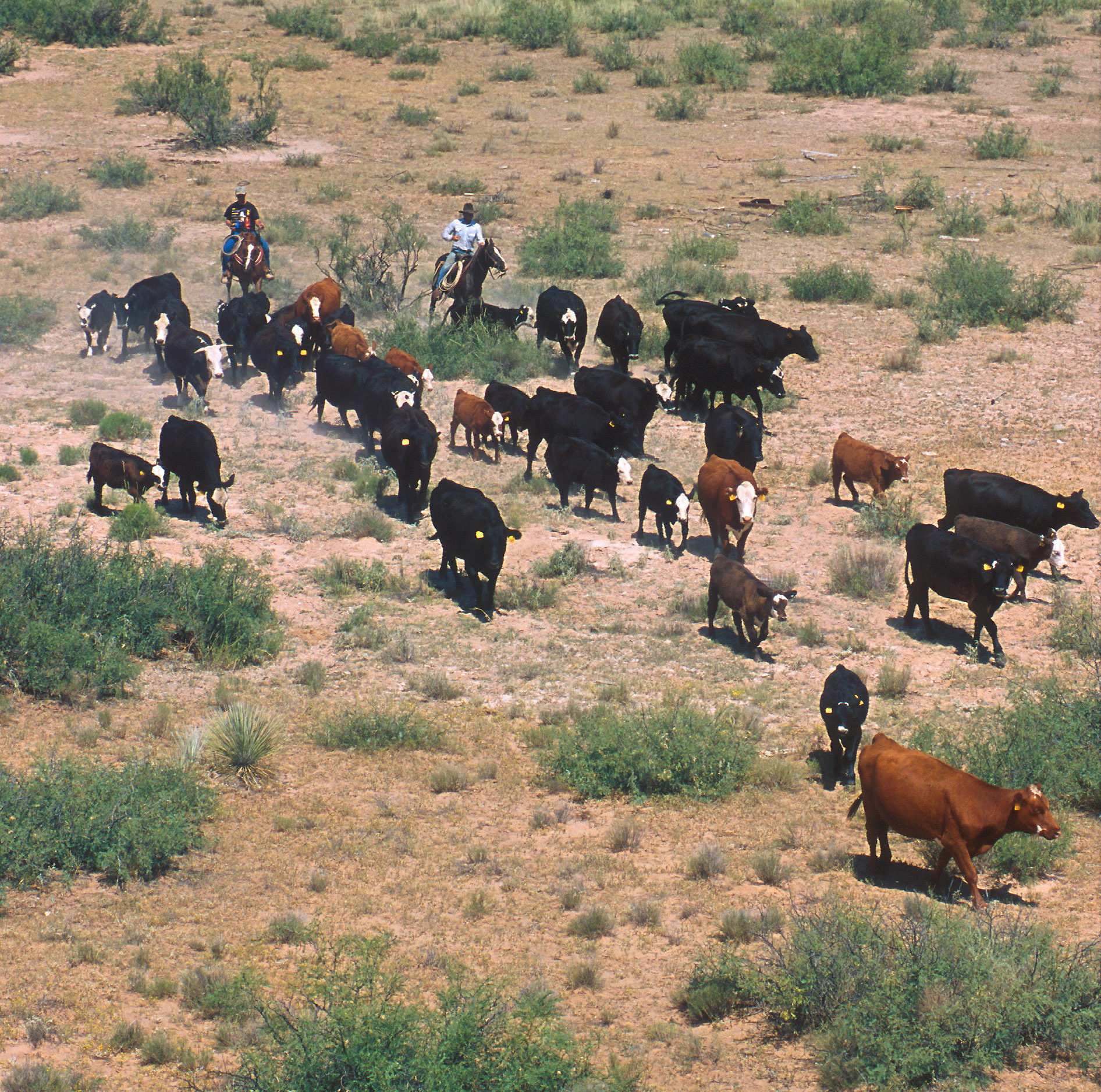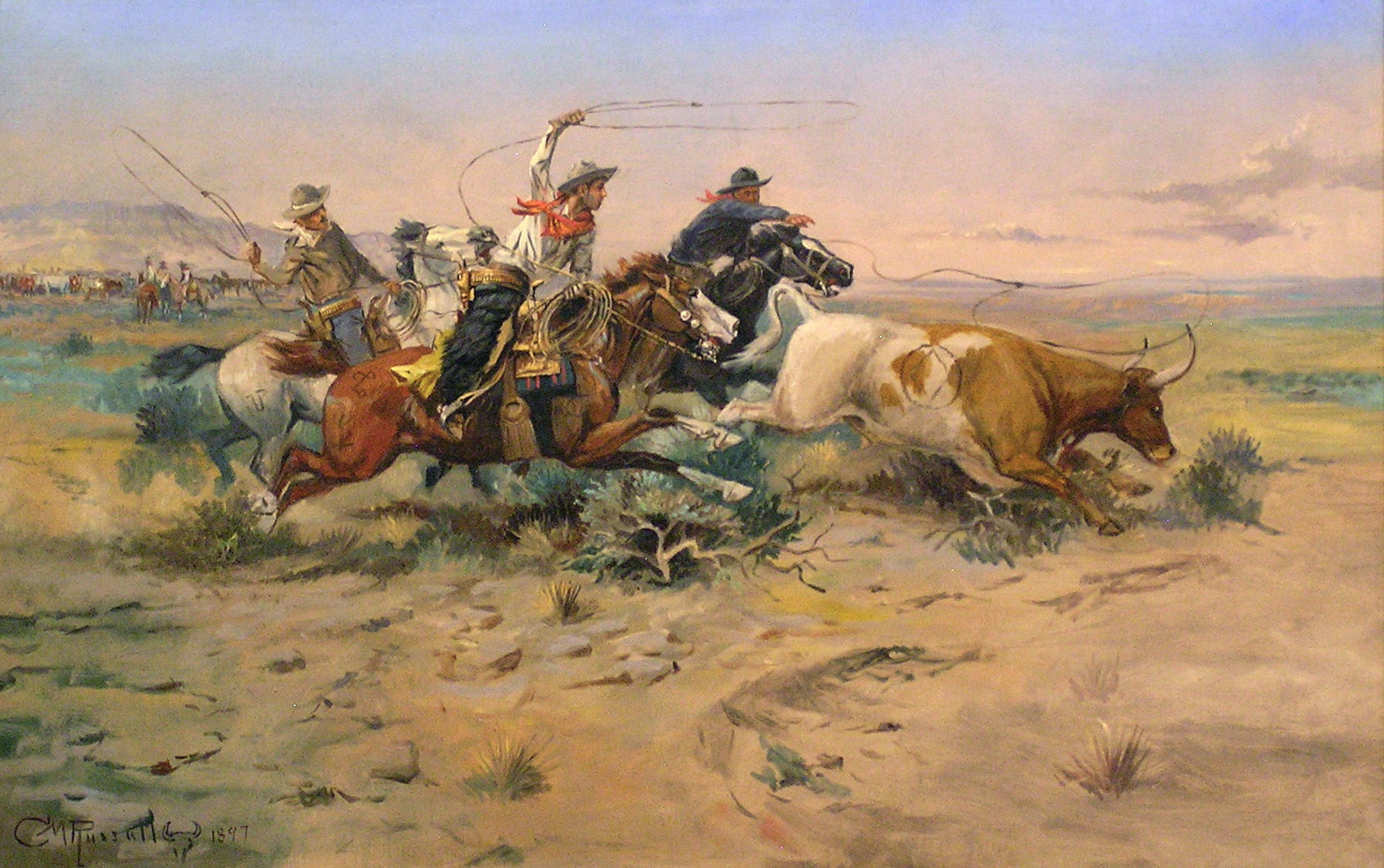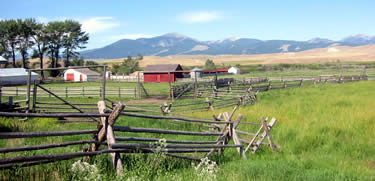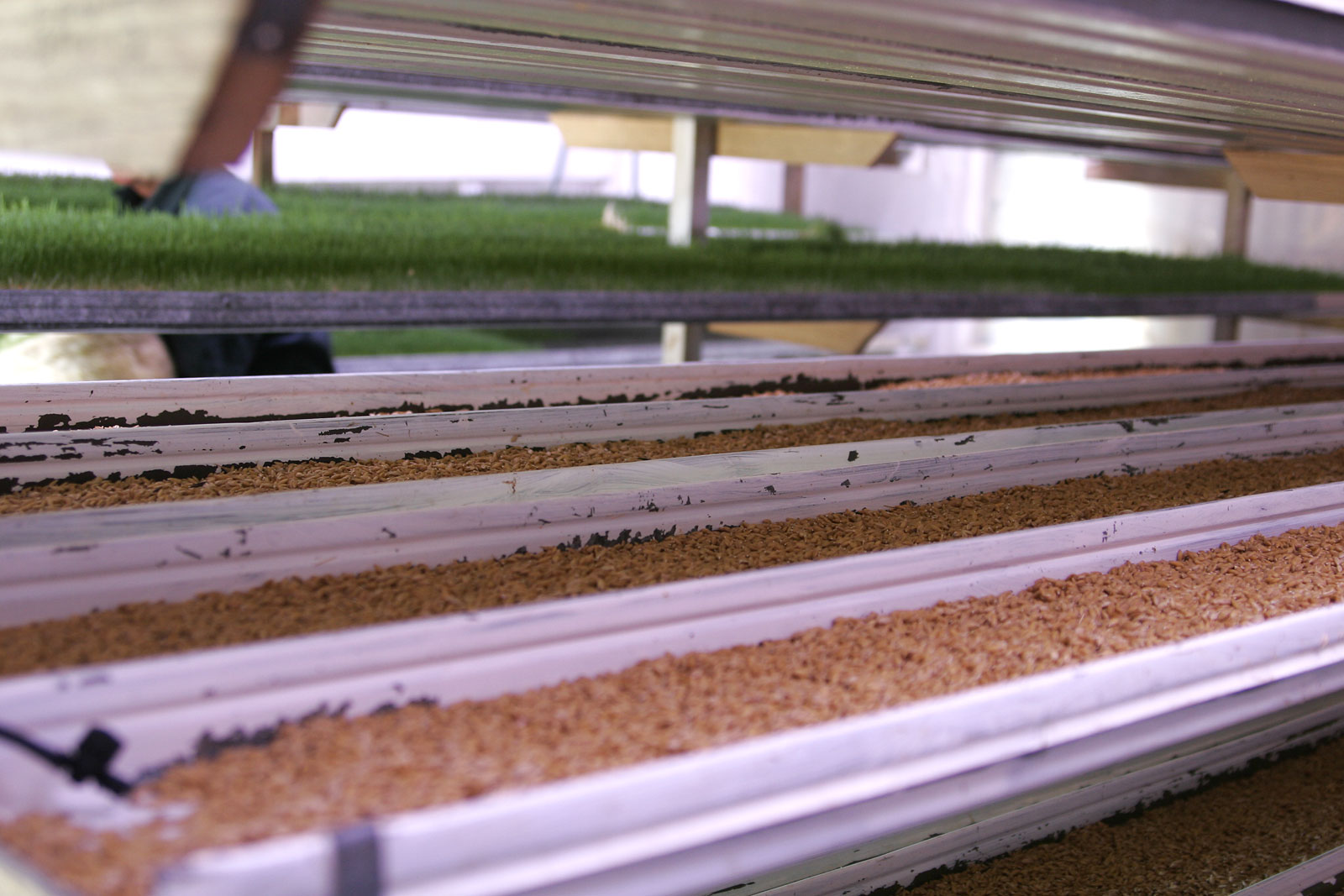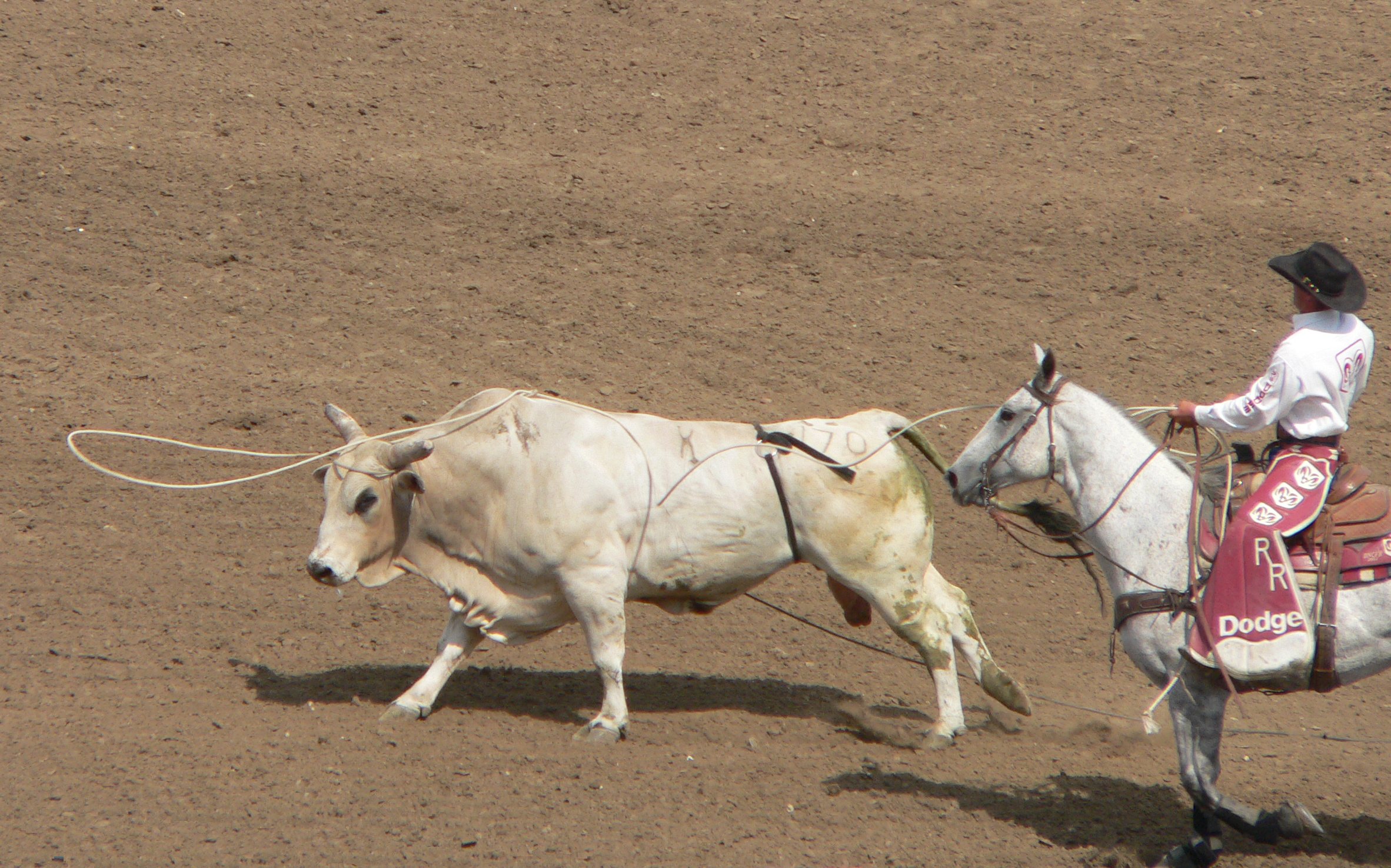|
Remuda
A remuda is a horse herd from which ranch-hands select their mounts. The word is of Spanish derivation, meaning 'remount', i.e.: "change of horses", and is in common use in the American West. The person in charge of the remuda is generally known as a wrangler. The wrangler provides spare horses during roundup, when cowboys change mounts three to four times a day. Necessity West of the Mississippi River, ranches are larger in acreage than are the farms to the east. Historically, cattle grazed, mostly unattended, on the open range before being rounded up and driven to market. In present times in early summer, cattle are released onto U.S. Forest Service or Bureau of Land Management lands, where the rancher pays the U.S. government for a lease, often of multiple sections of land. Most public land is still open range, unfenced or minimally fenced. Cattle are still rounded up and brought in off the range in the late summer and fall, with breeding stock sorted and moved to winter p ... [...More Info...] [...Related Items...] OR: [Wikipedia] [Google] [Baidu] |
Wrangler (profession)
In North America, a wrangler is someone employed to professionally handle animals, especially livestock, but sometimes other types of animals including bears, wolf packs, big cats, primates and reptiles. The word "wrangler" is derived from the Low German "wrangeln" meaning "to dispute" or "to wrestle". It was first documented in 1377. Its use as a noun was first recorded in 1547. Its reference to a "person in charge of horses or cattle" or "herder" was first recorded in 1888. A wrangler is an individual involved in the process of taming, controlling and handling various animals, specifically horses. Traditionally this process involves herding cattle and bringing horses in from the paddock. Wranglers often work for other cowboys or tourists who want to ride on North American ranches. Variations of wrangling include managing herds, dude-wrangling, rodeo and managing horses as a part of stunt work in the film industry. Wranglers are also considered a subcategory of cowboys, being re ... [...More Info...] [...Related Items...] OR: [Wikipedia] [Google] [Baidu] |
Cattle Drives In The United States
Cattle drives were a major economic activity in the 19th and early 20th century Western United States, American West, particularly between 1850s and 1910s. In this period, 27 million cattle were cattle drive, driven from Texas to railheads in Kansas, for shipment to stockyards in St. Louis and points east, and direct to Chicago. The long distances covered, the need for periodic rests by riders and animals, and the establishment of railheads led to the development of "cow towns" across the frontier. According to the Kraisingers, "...four Texas-based cattle trails - the Texas Road, Shawnee Trail System, the Goodnight-Loving Trail, Goodnight Trail System, the Chisholm Trail, Eastern/Chisholm Trail System, and Great Western Cattle Trail, The Western Trail System - were used to drive cattle north during the forty-year period between 1846 and 1886." Due to the extensive treatment of cattle drives in fiction and film, the horse has become the worldwide iconic image of the American West, ... [...More Info...] [...Related Items...] OR: [Wikipedia] [Google] [Baidu] |
Cowboy
A cowboy is an animal herder who tends cattle on ranches in North America, traditionally on horseback, and often performs a multitude of other ranch-related tasks. The historic American cowboy of the late 19th century arose from the ''vaquero'' traditions of northern Mexico and became a figure of special significance and legend.Malone, J., p. 1. A subtype, called a Wrangler (profession), wrangler, specifically tends the horses used to work cattle. In addition to ranch work, some cowboys work for or participate in rodeos. Cowgirls, first defined as such in the late 19th century, had a less-well documented historical role, but in the modern world work at identical tasks and have obtained considerable respect for their achievements. Cattle handlers in many other parts of the world, particularly South America and Australia, perform work similar to the cowboy. The cowboy has deep historic roots tracing back to Spain and the earliest European Settlement of the Americas, settlers of th ... [...More Info...] [...Related Items...] OR: [Wikipedia] [Google] [Baidu] |
Trailer (vehicle)
A trailer is an unpowered vehicle Towing, towed by a powered vehicle. It is commonly used for the transport of goods and materials. There are two general categories of trailers: the full trailer and the semitrailer. A full trailer is a type of trailer whose entire weight is supported by its own wheels, with no weight transferred to the towing vehicle. In contrast, a semi-trailer is designed so that a portion of its weight is carried by its own wheels, while the remaining weight is borne by the towing vehicle. Sometimes recreational vehicles, travel trailers, or mobile homes with limited living facilities where people can camp or stay have been referred to as trailers. In earlier days, many such vehicles were towable trailers. Trailers have been used for thousands of years, predating the invention of the automobile. Before the advent of the wheel, early humans employed the concept of trailering by using drag sleds to transport goods. While the two wheel war chariot is one of the ... [...More Info...] [...Related Items...] OR: [Wikipedia] [Google] [Baidu] |
Ranches
A ranch (from /Mexican Spanish) is an area of land, including various structures, given primarily to ranching, the practice of raising grazing livestock such as cattle and sheep. It is a subtype of farm. These terms are most often applied to livestock-raising operations in Mexico, the Western United States and Western Canada, though there are ranches in other areas.For terminologies in Australia and New Zealand, see Station (Australian agriculture) and Station (New Zealand agriculture). People who own or operate a ranch are called ranchers, cattlemen, or stockgrowers. Ranching is also a method used to raise less common livestock such as horses, elk, American bison, ostrich, emu, and alpaca.Holechek, J.L., Geli, H.M., Cibils, A.F. and Sawalhah, M.N., 2020. Climate Change, Rangelands, and Sustainability of Ranching in the Western United States. ''Sustainability'', ''12''(12), p.4942. Ranches generally consist of large areas, but may be of nearly any size. In the western United S ... [...More Info...] [...Related Items...] OR: [Wikipedia] [Google] [Baidu] |
Fodder
Fodder (), also called provender (), is any agriculture, agricultural foodstuff used specifically to feed domesticated livestock, such as cattle, domestic rabbit, rabbits, sheep, horses, chickens and pigs. "Fodder" refers particularly to food given to the animals (including plants cut and carried to them), rather than that which they forage for themselves (called forage). Fodder includes hay, straw, silage, compressed and Compound feed, pelleted feeds, oils and mixed rations, and sprouting, sprouted grains and legumes (such as bean sprouts, fresh malt, or brewing#Brewer's spent grain, spent malt). Most animal feed is from plants, but some manufacturers add ingredients to processed feeds that are of animal origin. The worldwide animal feed trade produced 1.245 billion tons of compound feed in 2022 according to an estimate by the International Feed Industry Federation, with an annual growth rate of about 2%. The use of agricultural land to grow feed rather than human food can be ... [...More Info...] [...Related Items...] OR: [Wikipedia] [Google] [Baidu] |
Lasso
A lasso or lazo ( or ), also called reata or la reata in Mexico, and in the United States riata or lariat (from Mexican Spanish lasso for roping cattle), is a loop of rope designed as a restraint to be thrown around a target and tightened when pulled. It is a well-known tool of the Mexican and South American cowboys, which was then adopted from the Mexicans by the cowboys of the United States. The word is also a verb; ''to lasso'' is to throw the loop of rope around something. Etymology The word ''lasso'' seems to have begun to be used as an English word in the early nineteenth century. It may have originated from the Castilian Spanish, Castilian word ''lazo'', which is first attested in the thirteenth century in the sense 'noose, snare', and derives in turn from classical Latin language, Latin ''laqueus'' ('noose, snare, trap, bond, tie'). The rope or lasso used to restrain cattle is also called ''Reata'' or ''La Reata'' in Mexico, which was Anglicized to “Lariat” or “R ... [...More Info...] [...Related Items...] OR: [Wikipedia] [Google] [Baidu] |
Old West
The American frontier, also known as the Old West, and popularly known as the Wild West, encompasses the geography, history, folklore, and culture associated with the forward wave of American expansion in mainland North America that began with European colonial settlements in the early 17th century and ended with the admission of the last few contiguous western territories as states in 1912. This era of massive migration and settlement was particularly encouraged by President Thomas Jefferson following the Louisiana Purchase, giving rise to the expansionist attitude known as "manifest destiny" and historians' " Frontier Thesis". The legends, historical events and folklore of the American frontier, known as the frontier myth, have embedded themselves into United States culture so much so that the Old West, and the Western genre of media specifically, has become one of the defining features of American national identity. Periodization Historians have debated at length as ... [...More Info...] [...Related Items...] OR: [Wikipedia] [Google] [Baidu] |
Feral Horse
A feral horse is a free-roaming horse of domesticated stock. As such, a feral horse is not a wild animal in the sense of an animal without domesticated ancestors. However, some populations of feral horses are managed as wildlife, and these horses often are popularly called "wild" horses. Feral horses are descended from domestic horses that strayed, escaped, or were deliberately released into the wild and remained to survive and reproduce there. Away from humans, over time, these animals' patterns of behavior revert to behavior more closely resembling that of wild horses. Some horses that live in a feral state but may be occasionally handled or managed by humans, particularly if privately owned, are referred to as " semi-feral". Feral horses live in groups called a ''herd'', ''band'', ''harem'', or ''mob''. Feral horse herds, like those of wild horses, are usually made up of small harems led by a dominant mare, containing additional mares, their foals, and immature horse ... [...More Info...] [...Related Items...] OR: [Wikipedia] [Google] [Baidu] |
Halter
A halter or headcollar is headgear placed on animals used to lead or tie up livestock and, occasionally, other animals; it fits behind the ears (behind the poll), and around the muzzle. To handle the animal, usually a lead rope is attached. On smaller animals, such as dogs, a leash is attached to the halter. History Halters may be as old as the early domestication of animals, and their history is not as well studied as that of the bridle or hackamore. The word "halter" derives from the Germanic words meaning "that by which anything is held." One halter design was patented in the United States by Henry Wagner of Toledo, Iowa February 13, 1894. Uses A halter is used to control an animal when leading on the ground, and as a restraint when tying them up. [...More Info...] [...Related Items...] OR: [Wikipedia] [Google] [Baidu] |
Pen (enclosure)
A pen is a fenced/ walled open-air enclosure for holding land animals in captivity, typically for livestock but may also be used for holding other domesticated animals such as pets that are unwanted inside buildings. The term describes types of enclosures that may confine one or many animals. Construction and terminology vary depending on the region of the world, purpose, animal species to be confined, local materials used and tradition. ''Pen'' or ''penning'' as a verb refers to the act of confining animals in an enclosure. Similar terms are kraal, boma, and corrals. Encyclopædia Britannica notes usage of the term "kraal" for elephant corrals in India, Sri Lanka, and Thailand. Australia and New Zealand In Australia and New Zealand a ''pen'' is a small enclosure for livestock (especially sheep or cattle), which is part of a larger construction, e.g. ''calf pen'', ''forcing pen'' (or yard) in sheep or cattle yards, or a ''sweating pen'' or ''catching pen'' in a sheari ... [...More Info...] [...Related Items...] OR: [Wikipedia] [Google] [Baidu] |
Texas Longhorn
The Texas Longhorn is an American breed of beef cattle, characterized by its long horns, which can span more than from tip to tip. It derives from cattle brought from the Iberian Peninsula to the Americas by Spanish conquistadors from the time of the Second Voyage of Christopher Columbus until about 1512. For hundreds of years the cattle lived a semi-feral existence on the rangelands; they have a higher tolerance of heat and drought than most European breeds. The coat can be of any color or mix of colors; in some 40% of the cattle it is some shade of red, often a light red. In the twenty-first century, the Longhorn is considered a part of the cultural heritage of Texas. History The Texas Longhorn derives from cattle brought to the Americas by Spanish conquistadors from the time of the Second Voyage of Christopher Columbus until about 1512. The first cattle were landed in 1493 on the Caribbean island of La Isla Española (now known as Hispaniola) to provide food for ... [...More Info...] [...Related Items...] OR: [Wikipedia] [Google] [Baidu] |

